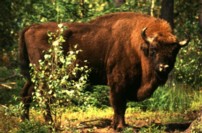

Common Names: Wisent, Zubr, Zubor
Genus: Bison
Species: bonasus

The story of the European bison, or wisent, is a story of an amazing return from the brink of extinction by a species. At one time, the bison roamed the temperate European deciduous forest biome from British Isles, through most of Europe into Siberia. By the Middle Ages, in the 15th century, the bison had become all but extinct in many countries, and had died out entirely in Czechoslovakia. They survived in the wild into the 20th
century only in Poland and Caucasia, where they lived protected and fed in royal hunting forests well into the 18th century. A poacher shot the last wild Polish bison in 1919, and last wild Caucasus bison was killed in 1925. Only 54 bison remained in zoos and private parks. Almost immediately, a drive was organized to bring the bison back. In 1929, Poland bought two cows and a bull from Sweden and Germany and brought them to a breeding station in the Bialowieza forest. During World War II the bison were protected by both the Germans and the Russians, when killing one became punishable by death. The first two bulls were released into the Bialowieza National Park in 1952, with several cows following soon after. In 1957 the first calf was born into the wild. Since 1980 more than 20 herds have been reintroduced into Poland.
Today the largest concentration of European bison can be found in Poland's Bialowieza National Park. The park is a 20 square mile area located inside the 220 square mile Bialowieza Forest, and borders Belarus' Beloveskaja Pusca National Park. A large fence divides the forest along the border of the two countries, and separates the herds from each other. Currently their range includes Belarus, Kyrgyzstan, Lithuania, Poland, Ukraine, and the Russian Federation. The bison prefers flat, moist deciduous or mixed forests. Temperatures in January average 25° F in the Bialowieza Forest, and the average snow cover lasts 92 days a year. Traditionally the bison have been fed during the winter, a practice that survives today.
There are two subspecies of Bison bonasus. The lowland bison (Bison bonasus bonasus) consists of about 1,000 animals. Of these about 69% range freely in Poland, Belarus, Russia, Lithuania, Romania, and the Ukraine. The highland or Caucasus bison (Bison bonasus caucasus) has been interbred with lowland bison, and no true line remains of this species. About 2,200 survive, of which about half live in the wild.
The bison is the largest and heaviest mammal on the European continent. They are smaller, and have longer legs than the American bison. The hair on the back of the neck is shorter, which also making them look smaller than their American cousin. Even so, the bulls can stand over 6 feet tall, and be over 9 feet long. Males are larger than females. A thick, dark brown, shaggy mane covers the head, neck, and front legs. In the autumn their coat becomes thicker in anticipation of winter. Both males and females have short horns that curve inward on the males, but are straighter on the females. These horns are permanent and don't branch off at any point.
In the winter, the bisons form large mixed herds that stay close to feeding stations. In the spring they break up into smaller maternal and male groups. Maternal groups consist of adult cows, calves and juveniles, while the male groups consist of bachelor males. Older males will often go their own way. The same set of cows tend to stay together from year to year. The bulls will stay in separate groups during the calving season, and rejoin the mixed groups during the rut, or mating season.
During mating season, which lasts from August to October, a bull will move between groups looking for cows in estrus. He will attend her for several days before mating. During this time he will try to prevent any other bull from getting near her. Some bulls are severely injured during these head-butting bouts. After mating, the bull will leave the cow to look for another cow ready to mate. The pregnancy lasts for about nine months, and the calves are born from May to July. The mother leaves the herd to give birth to her calf, which is able to run only hours after it is born. The calf will nurse for about a year, or until its mother has another calf. Cows usually have a calf every year. bison reach sexual maturity in three to four years. Their life expectancy is up to 25 years.
Unlike their American cousins, who live on the open grasslands of the Midwest, the European bison is a woodland animal. It browses on deciduous trees, leaves, twigs, young shoots, bark, and berries. Favorite foods include willow, aspen, ash, mistletoe, and blackberry. They will also eat mushrooms, ferns, lichens, mosses, and acorns. In the winter, the park personnel feed them oats, hay, and sugar beets.
According to the 2000 IUCN Red Data List the European bison is an endangered species, and is protected. One of the largest threats to the European bison is further reduction of their range. Another significant threat is inbreeding. Since all the bison alive today come from a small survivng core group, there is not a great variety in the makeup of their genes. This makes the bison susceptable to diseases, decreases their life span, increases juvenile mortality, and the intervals between the birth of calves. The bison are also susceptabel to the diseases of domestic cattle, like hoof and mouth disease, pasturellosis, and parasites.
Bibliography:
"European Bison
Biogeography",
http://www.sfsu.edu/~geog/bholzman/courses/316projects/bison.html,
(7/28/'03)
"European Wisent
Bison bonasus",
http://www.csew.com/cattletag/Cattle%20Website/Fact_Sheets
/European_Bison/european_bison.htm,
(July, 2003)
"Nature Conservation
- European Bison (Bison bonasus)",
http://www.telecom.gov.sk/znamky/1996/96097e.html
(July,
2003).